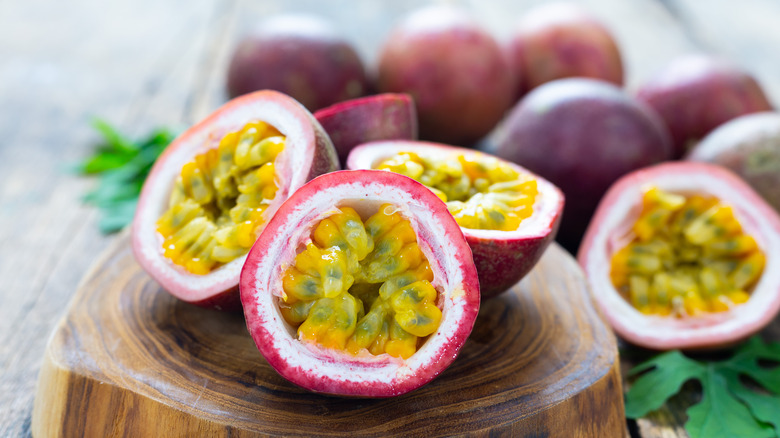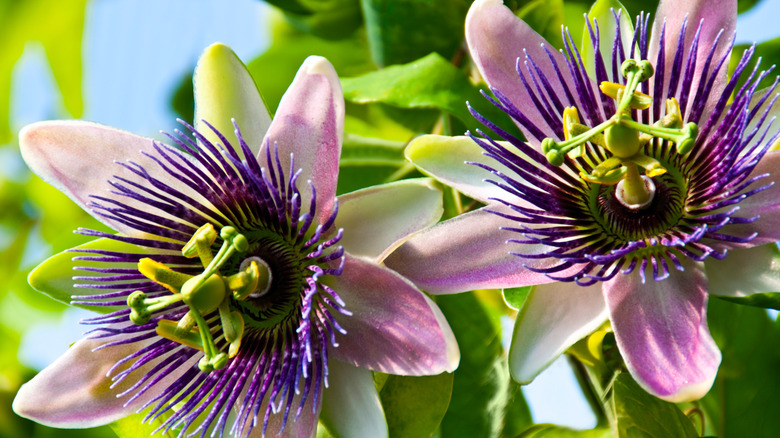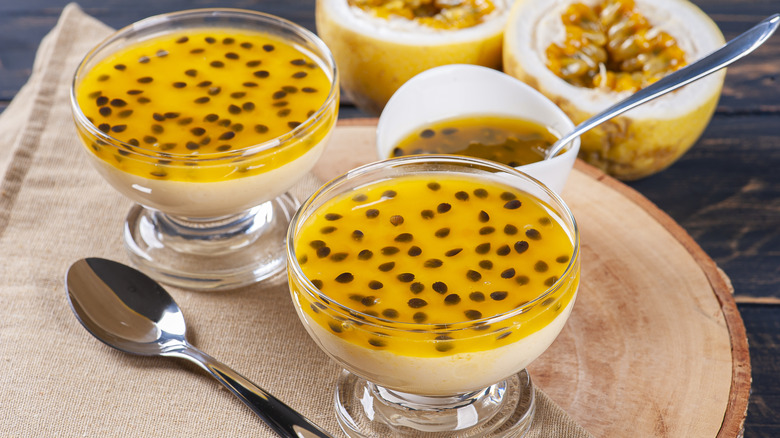What Is Passion Fruit And How Do You Eat One?
Passion fruit is a beautiful tropical food, but it can be intimidating. Even the passion flower looks like an alien life form. For those unfamiliar with this spectacular flora, a host of questions might spring to mind. What does one do with the gelatinous insides of the fruit? They seem mushy. Is that normal? What does a ripe passion fruit look like? When is it in season and where does it come from? What will it taste like?
Luckily, with just a bit of instruction, the fruit isn't too complicated to work with, and a little background knowledge might just make you more interested in approaching the naturally tart treat. Passion flower and passion vine have been used for hundreds if not thousands of years by Indigenous people in their own medicines, and the fruit is enjoyed widely for its deliciously sweet flavor and scent. Using it in your own kitchen is actually quite easy.
Form and function
Arguably more visually stunning than the cut fruit itself, the passion flower is named for the Christian story of the Passion of Christ. Jesuit missionaries in South America didn't see the plant as otherworldly — though its wiry filaments and sharply contrasting colors may seem so to others — but rather as holy. These missionaries felt that the plant connected to elements of the story of Jesus' last moments on earth. The petals were said to symbolize the apostles. The filaments, meanwhile, form a spiky corona which evoked his crown of thorns in their minds, and they used the flower in their quest to convert people to Christianity and teach them about the resurrection.
Indigenous people had long used the plant, which grows native in North, Central, and South America, for healing purposes. Containing magnesium, it is said to calm nerves and headaches. It was also used to help with insomnia and other sleep issues, though some ethnobiologists point out that it is the roots and leaves which are used for these effects and not the fruit.
In North America, passion fruit is in season in Florida from June to December, in California from January into November, and in Hawaii more or less year-round.
Enjoying passion fruit
The fruit is considered very healthy, offering a dose of vitamin C and potassium. It is also recognized as being high in fiber and helpful in potentially increasing insulin sensitivity for patients with diabetes.
With over 500 varieties of passion flowers, many of them fruiting, only a few are actually grown for culinary use (these can be either yellowish or a deep purple color). The fruit is small and round, like an egg, and becomes wrinkled when ripe. If it seems heavy for its size, that's a good sign.
To prepare it, wash the fruit thoroughly and then cut it in half. Inside, you'll find jelly-like golden orange pulp surrounding small, piquant black seeds, which you eat whole, crunching them the way you might with pomegranate arils or prickly pear. Scoop them out or eat them right from the fruit's surrounding pith, which is white on the inside.
The delicious, brightly floral aroma might already be familiar from smoothies and juices prepared commercially. Remember the Starbucks Guava Passionfruit Drink and the creative La Croix flavors? There are plenty of ways to incorporate passion fruit into your own kitchen. Try a seared mahi-mahi with passion fruit sauce or pair it with other fruits in smoothies and desserts like passion fruit-mango mousse or in smoothie bowls.


